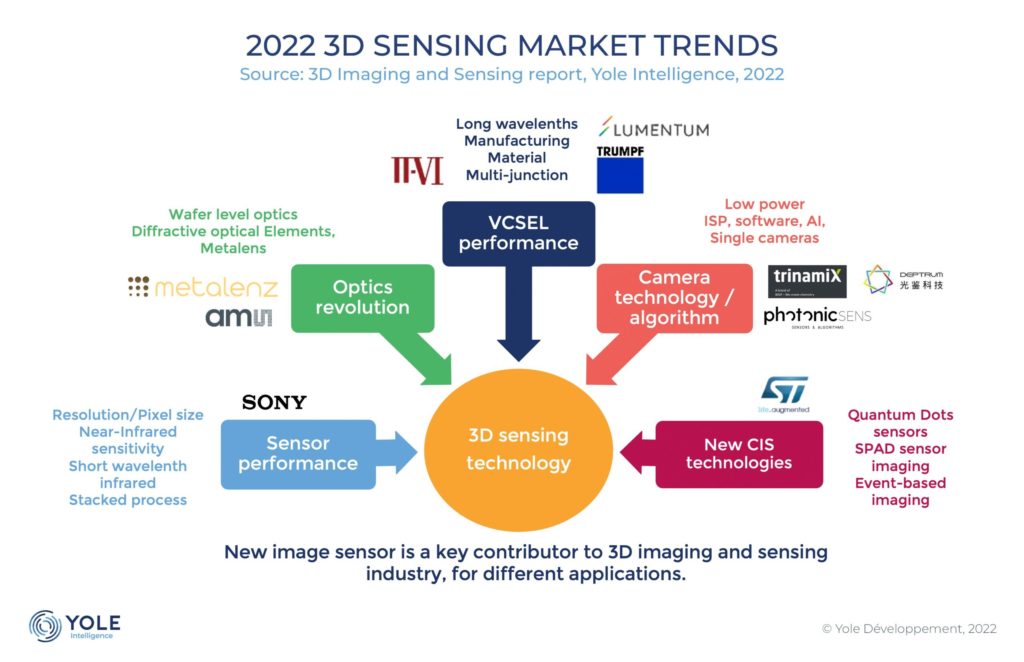This market research report was originally published at Yole Développement’s website. It is reprinted here with the permission of Yole Développement.
3D sensing will be worth US$16.7 billion in 2027. But, will the metaverse be the killer app that drives Android adoption?
OUTLINE
-
The global 3D imaging and sensing market is expected to reach US$16.7 billion in 2026.
-
3D imaging and sensing solutions are spreading beyond mobile phones to other markets, such as automotive, industrial, and consumer.
-
3D-sensing technology emerged in the mobile and consumer market, which nurtured and developed a fairly solid supply chain.
Yole Intelligence, part of Yole Group, has developed comprehensive and in-depth imaging expertise for over ten years. Throughout the year, our analysts research the market and deliver their analyses in a wide collection of technology and market reports and teardowns… More information.
Today, Yole Intelligence’s imaging team releases its annual report, 3D Imaging and Sensing. This report provides a comprehensive and up-to-date description and analysis of the ecosystem. It highlights the market dynamics and technological evolution. Furthermore, it provides insights into the constraints and challenges of the 3D imaging and sensing industry.
“As expected, in 2021, the Android smartphone camp saw no progress in mobile 3D sensing. However, the leading smartphone manufacturer, Apple, continues to adopt 3D camera solutions in both front and rear applications, even updating face ID, by simplifying and shrinking its optical structure. That’s Apple’s strategy to push 3D sensing on its phones, further appealing to consumers.”
Richard Liu
Technology & Market Analyst, Imaging and Display at Yole Intelligence
iPhone sales soared in 2021, boosting the total mobile and consumer 3D camera revenue to about US$3.6 billion or 326 million units in 2021, slightly higher than Yole Intelligence’s previous estimates.
There are two main challenges to adopting 3D cameras in Android phones:
- One is the competitors to 3D cameras for specific apps such as front-facing 3D sensing applications like under-display fingerprint sending, which are cost-effective and work well.
- The other is a shortage of applications. If a 3D camera is placed on the rear of the phone, there should be at least one killer application for daily use. But there are only a few AR games or other infrequently used applications. This latter challenge is what Yole intelligence thinks is the real reason behind the Android camp’s strategy. Yet, with the continuous increase in the share of Apple’s mobile phones, the penetration rate of 3D sensing in mobile phones is also increasing.
How will Android phones compete when consumers become more aware of and embrace 3D sensing? Indeed, they will need to deliver the same functionality as Apple and even surpass it, as Huawei has done before, explains Yole Intelligence in its 3D imaging and sensing report.

Once Android phones adopt this strategy, 3D sensing will return to Android phones. Recently Honor adopted 3D sensing in its flagship phone, the Magic 4 Pro. We assume it is just using it on its flagship models, similar to Apple. As such, Yole Intelligence continues to be bullish on this market. Its imaging team expects the mobile 3D sensor market to reach US$6.6 billion in 2027, with a CAGR of 11.9%.
In addition to mobile phones, 3D sensing is blossoming in other industries. As 3D sensing has temporarily come to a standstill in Android phones, upstream device suppliers or integrators have to work hard to open up other consumer markets. For example, smart door locks, robot cleaners, and smart fitness have made progress and seen further penetration. In 2021, the concept of the metaverse stimulated a new understanding of 3D sensing in the market. The metaverse desperately needs 3D sensing technologies, such as virtualized worlds and digitization, and ways of interacting in virtual worlds, such as eye and lip tracking. This will greatly incentivize more players to participate in developing 3D sensing technology.

In industrial 3D sensing, traditional LiDAR is suitable for topographic and infrastructural applications. With the rise of machine vision, 3D cameras are also performing more delicate and complex work in manufacturing, logistics, and public security, and will continue to grow rapidly.
Automotive 3D sensing for ADAS and DMS is just starting, though its growth is expected to exceed other markets, and the prospects are huge. According to Yole Intelligence’s research, 3D sensing in automotive will go from US$530 million in 2021 to US$3.01 billion in 2027, which is amazing.
Yole Intelligence’s imaging team invites you to follow the imaging industry on www.yolegroup.com. Stay tuned!
Acronyms
- AR : Augmented Reality
- CAGR : Compound Annual Growth Rate
- LiDAR : Light Detection and Ranging
- DMS : Driver Monitoring Systems


